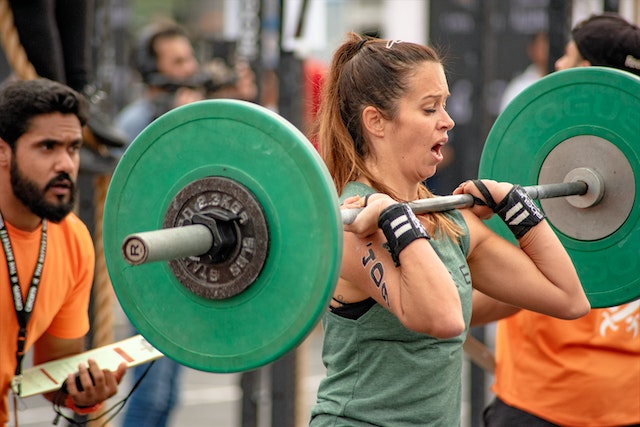Are you someone who’s been sweating it out on the treadmill or elliptical but not seeing significant results in your weight loss journey? Don’t worry, you’re not alone. Cardio exercises are great for improving heart health and burning calories, but they may not be enough to help you shed those extra pounds. In fact, research has shown that lifting weights is just as important (if not more) than cardio when it comes to weight loss success. So, if you want to learn why cardio alone won’t cut it and how lifting weights can actually take your fitness game up a notch, keep reading!
What is Cardio?
Cardio, short for cardiovascular exercise, refers to any form of physical activity that elevates your heart rate and increases oxygen circulation throughout the body. This type of exercise involves repetitive movements using large muscle groups such as running, cycling, swimming or dancing.
The primary goal of cardio is to improve overall cardiovascular health by strengthening the heart and lungs and increasing endurance. It also aids in burning calories which can lead to weight loss when combined with a healthy diet.
There are different types of cardio exercises you can do depending on your fitness level and preferences. Low-impact options like walking or using an elliptical machine are great for beginners or those with joint pain while high-intensity interval training (HIIT) workouts can be done by more advanced individuals looking for a challenge.
While cardio is beneficial for many reasons, it may not be enough if you’re solely relying on it to achieve your weight loss goals. Incorporating lifting weights into your routine could help take things to the next level!
The Different Types of Cardio
Cardiovascular exercise, or cardio as it is commonly known, refers to any physical activity that increases the heart rate and breathing rate. There are several types of cardio exercises, including low-impact options like walking and swimming as well as high-intensity options like sprinting and spinning.
Low-impact cardio exercises are great for beginners or those with joint pain. Walking is a simple yet effective form of low-impact cardio that can be done anywhere at any time. Swimming is also a great option because it puts less strain on the joints while still providing an excellent cardiovascular workout.
High-intensity interval training (HIIT) has grown in popularity over the years due to its effectiveness in burning calories in a short amount of time. HIIT involves alternating between periods of intense exercise and rest for a set amount of time.
Sprinting is another type of high-intensity cardio that can be done outside or on a treadmill. It requires maximum effort for short bursts followed by recovery periods.
There are many different types of cardio workouts to choose from depending on your fitness level and goals. Incorporating variety into your routine can help prevent boredom and ensure you get the most out of your workouts.
Pros and Cons of Cardio
Cardiovascular exercise, or simply cardio, is a type of physical activity that gets your heart rate up and involves large muscle groups. There are different types of cardio exercises such as running, cycling, swimming and dancing.
Pros:
One of the biggest benefits of doing cardio regularly is its impact on your cardiovascular health. It helps to lower blood pressure and reduces the risk of heart disease. Cardio also helps in burning calories which makes it an effective tool for weight loss. Moreover, it can boost mood by releasing endorphins into the body.
Cons:
However, there are some downsides to relying solely on cardio for weight loss or fitness goals. Doing too much cardio without any strength training can lead to muscle loss which slows down metabolism over time. This may result in less calorie burn even when you’re not exercising.
Another downside is that excessive cardio can cause wear and tear on joints leading to injury if done improperly or with poor form.
It’s important to incorporate both cardiovascular exercise and strength training into your workout routine for optimum results.
What are the benefits of lifting weights?
Lifting weights is an excellent way to improve your overall health, increase muscle mass and strength, and burn fat. In fact, lifting weights offers a range of benefits that go beyond just building muscles.
One of the main advantages of weightlifting is that it helps boost your metabolism. When you lift weights correctly, you develop lean muscle tissue in your body which burns calories even when you’re not working out. This means that by incorporating weight training into your routine, you can continue burning fat long after your workout session has ended.
Another advantage of lifting weights is improved bone density and joint flexibility. As we age, our bones become weaker and more brittle due to loss of calcium content. By lifting heavyweights regularly, we can stimulate bone growth and prevent osteoporosis from setting in.
Research also shows that resistance training can help enhance cognitive function by increasing blood flow to the brain leading to better memory retention over time.
In addition to these physical benefits, weightlifting boosts confidence levels as well as self-esteem through visible changes such as toned arms or abs resulting from consistent effort put into exercise regimes.
Finally yet importantly , if done safely with proper guidance , weightlifting provides the opportunity for individuals seeking personal development both physically and mentally .
How to lift weights effectively
When it comes to lifting weights, technique is everything. It’s important to start with a weight that you can handle comfortably and gradually increase the amount over time. This will help prevent injury and ensure that your muscles are getting the most out of each exercise.
Form is also crucial for effective weightlifting. Make sure that you are using proper posture and engaging the correct muscle groups during each lift. For example, when doing a squat, make sure your knees are aligned with your toes and keep your back straight throughout the movement.
Resting between sets is another key factor in effective weightlifting. Give yourself enough time to recover before starting your next set, but don’t wait too long as this can cause your muscles to cool down and lose momentum.
Be consistent with your workouts. Aim to lift weights at least two or three times a week on non-consecutive days for optimal results. Remember that progress takes time so don’t get discouraged if you’re not seeing immediate changes – stick with it and stay committed!
Conclusion
While cardio is a great way to burn calories and improve cardiovascular health, it shouldn’t be the only exercise you rely on for weight loss success. Incorporating strength training into your workout routine can lead to significant improvements in body composition, metabolism, and overall fitness. By challenging your muscles with weights or resistance exercises, you’ll not only build lean muscle but also increase your calorie-burning potential throughout the day.
Remember that lifting weights doesn’t mean you have to become a bodybuilder or spend hours at the gym every day. Even just a few strength-training sessions per week can make a big difference in your weight loss journey.
So next time you hit the gym, consider adding some dumbbell curls or squats to your routine. Your waistline (and overall health) will thank you!











